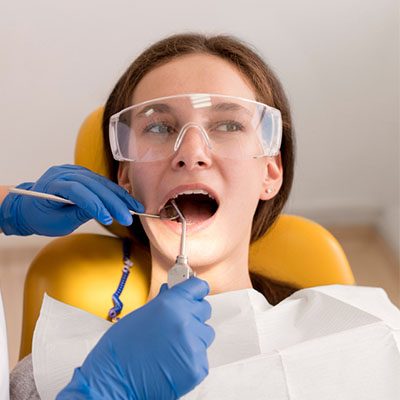Tooth Extractions
Tooth Extractions Thornton
 Modern dentistry aims to preserve your natural teeth whenever possible. To stop the infection from spreading, teeth that are severely decaying or damaged may need to be extracted.
Modern dentistry aims to preserve your natural teeth whenever possible. To stop the infection from spreading, teeth that are severely decaying or damaged may need to be extracted.
- Risk of infection due to other health issues, such as a compromised immune system
- Impacted teeth
- Crowded mouth
- Orthodontic necessities
- Financial considerations in which a reduced price is necessary
A tooth may be removed while under local anaesthetic. Sedation or general anaesthesia might also be used depending on the treatment’s complexity. Your Thornton, Maitland NSW dentist may prescribe antibiotics for you, depending on the procedure’s complexity and the infection risk.
Extraction Process
- Consultation and Examination: The dentist or oral surgeon examines the tooth and surrounding area using X-rays to assess the situation and plan the extraction.
- Anaesthesia: Local anaesthesia is used to numb the area around the tooth. General anaesthesia or sedation may be used for surgical extractions.
- Extraction: Your Thornton dentist uses forceps to remove the tooth after loosening it using an elevator. During a surgical extraction involving making an incision in the gum, the tooth may be sectioned into smaller pieces for easier removal.
-
Aftercare: The dentist provides instructions for post-extraction care, typically managing pain with medicines, avoiding strenuous activity, and maintaining oral hygiene. Patients are advised to avoid smoking, drinking through a straw, and consuming hard or chewy foods to encourage healing and safeguard against issues like dry sockets.
Complications and Recovery
- Pain
- Bleeding
- Swelling and bruising
- Infection
- Dry socket
- Damage to nearby teeth
- Sinus exposure
- Broken jaw
- Inability to fully open mouth
- Jaw stiffness
- Damage to nerves
- Bisphosphonate-associated osteonecrosis of your jaw
Recovering from the treatment is easy and simple. You should not worry about recovering from an extraction procedure, even in severe cases. Most patients recover from the pain in just one to two days. After a week, they can stop taking particular concerns with the extraction site and return to their routine.
Tooth Extractions in Thornton
Generally, tooth extraction is a very safe procedure with no complications. However, difficulties can occur in some situations, just like with any medical procedure; thus, informing your dentist about your medicines, health issues, and anxieties before the treatment starts is essential.
At Thornton Dental, we are highly skilled dental professionals with extensive knowledge of extractions and other complex dental procedures. If you encounter any problems, your dentist is always ready to re-examine you and take the necessary steps to resolve any anomalies quickly and safely.
Call us on (02) 4966 2996 to book your appointment online today!
Any surgical or invasive technique has potential dangers. It would help if you got a second opinion from a medical practitioner with the necessary licence before taking further action.
Visit us at Thornton Shopping Centre, Shop 30/1 Taylor Ave in Thornton.
FAQs
Why might I need a tooth extraction?
Tooth extractions are necessary for severe decay, infection, overcrowding, gum disease, or impacted wisdom teeth.
Is the procedure painful?
Local anaesthesia or sedation is used, so you should not feel pain during the extraction. Some discomfort afterwards is normal and can be managed with pain medicine.
How long is the recovery time?
Recovery usually takes a few days to a week, depending on the individual’s healing process and the complexity of the extraction.
What can I eat after an extraction?
Soft foods like yoghurt, applesauce, and mashed potatoes are recommended. Avoid complex, chewy, spicy, or hot foods.
How do I care for the extraction site?
Keep the area clean, avoid vigorous rinsing or spitting, use an ice pack to reduce swelling, and follow your dentist’s instructions for care.
Are there risks involved?
Risks include infection, dry socket, prolonged bleeding, and damage to nearby teeth or nerves. Following post-operative care instructions minimise these risks.
Can I go back to work or school after an extraction?
It depends on the complexity of the extraction. Many people return to normal activities the next day, but rest is recommended for at least 24 hours.
How do I manage pain and swelling after the extraction?
Use prescribed or over-the-counter pain relievers and apply ice packs to reduce swelling.
When should I contact my dentist?
Contact your dentist if you have excruciating pain, profuse bleeding, fever, swelling, or infection symptoms or if the extraction site is not healing.
Can I smoke or drink alcohol after an extraction?
After the extraction, avoid alcohol and tobacco use for at least 48 hours to minimise issues and encourage recovery.
How long should I wait before brushing my teeth?
You can gently brush your teeth after 24 hours, carefully avoiding the extraction site.
What should I do if the blood clot dislodges?
If you feel that you have a dry socket, intense discomfort, or a loose blood clot, contact your dentist immediately.
Can I exercise after a tooth extraction?
Avoid strenuous activities for at least 24-48 hours after the extraction to prevent complications.
